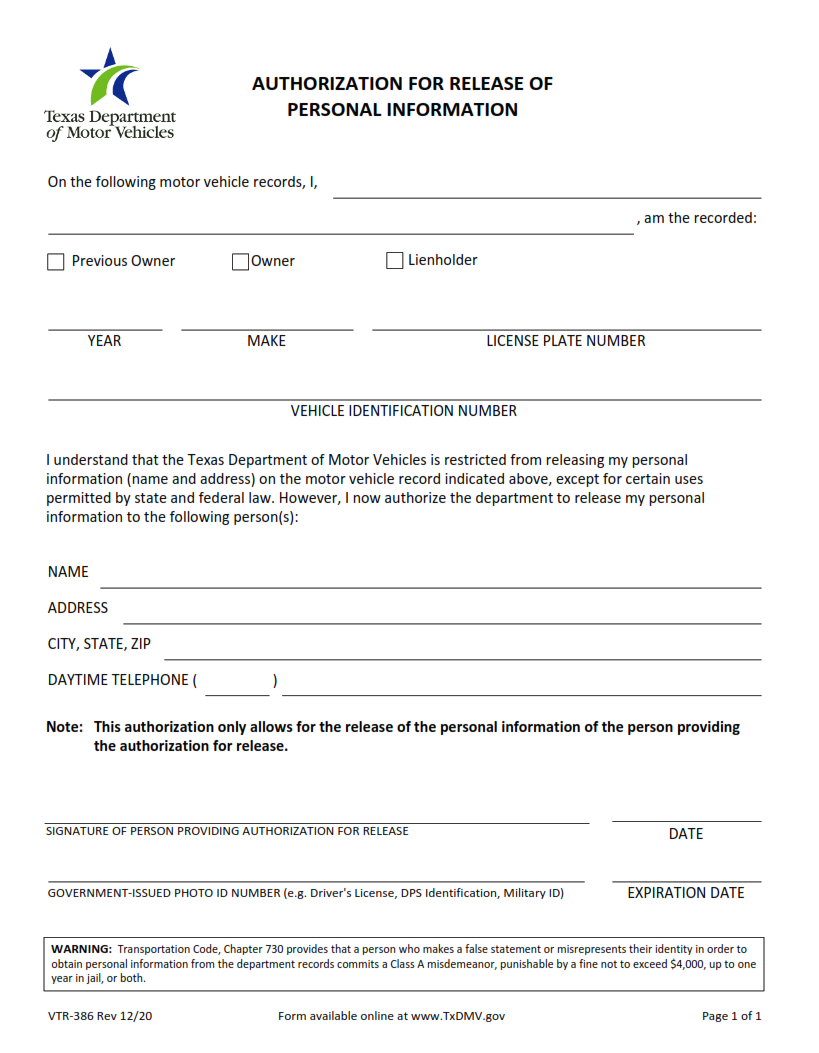ORIGINFORMSTUDIO.COM – VTR-386 – Authorization for Release Of Personal Information – The authorization of personal information is a critical part of ensuring the security and privacy of individuals. The VTR-386 form is used to authorize the release of personal information when needed. This document outlines the requirements for obtaining signed authorization before releasing any individual’s personal information. It details exactly what must be included in the authorization, such as the identity of both parties involved, a description of the data being requested, and an expiration date. Additionally, it explains who can sign this form and what protections are given to those who provide their personal information.
Download VTR-386 – Authorization for Release Of Personal Information
| Form Number | VTR-386 |
| Form Title | Authorization for Release Of Personal Information |
| File Size | 2 MB |
| Form By | Texas DMV Form |
What is a VTR-386 Form?
The VTR-386 Form is an authorization form created by the Texas Department of Motor Vehicles. This form is required when requesting the release of a person’s personal information, such as their driving records or vehicle titles. It allows the DMV to confirm that a person has authorized access to their information and that it can be released to those who are entitled to it.
In order for a VTR-386 Form to be valid, it must be completed in its entirety and signed by both parties involved in making the request. It should include detailed instructions on how the release will take place and other relevant information such as the name of the individual whose information is being requested, contact details for all parties involved, and any additional documents needed for verification purposes. Once submitted, processing typically takes 3-5 business days.
What is the Purpose of the VTR-386 Form?
The VTR-386 form is a document used to provide the Texas Department of Motor Vehicles (TxDMV) with authorization for the release of personal information. This form is typically used by third parties, such as insurance companies, in order to verify vehicle registration information or access records related to a vehicle owner.
When applying for a vehicle registration, an individual must provide their full name, address, date of birth and driver’s license number. The TxDMV may need to share this information with other agencies and entities in order to process certain requests. The VTR-386 Form grants permission for the release of this personal data. In addition, it also allows individuals to specify exactly what type of data they are willing to have released.
Where Can I Find a VTR-386 Form?
If you are looking to obtain a VTR-386 form, you may be able to find the document in multiple places. In Texas, the official form is available on the Texas Department of Motor Vehicles (TxDMV) website. You can download it directly from their site and print it out for your convenience. Additionally, many county tax offices have copies of the forms available as well.
Aside from physical locations, electronic versions of the VTR-386 form exist online as well. A quick search engine query should bring up several different versions that you can fill out digitally and submit electronically or print out for your records. Be sure to use an official version when submitting paperwork to ensure accuracy and security of your information.
VTR-386 – Authorization for Release Of Personal Information
The VTR-386 is an authorization form for the release of personal information. This document is typically used when a person wants to give permission for their personal information to be released to another party. The form can be used for many different reasons, such as providing proof of residence, allowing access to financial records, or authorizing a third-party vendor to view and use private data.
Using the VTR-386 ensures that any party receiving the material understands their responsibilities with regard to handling and protecting sensitive information. Additionally, it allows individuals to establish conditions that must be met before information can be shared with another entity. These conditions may include validating the identity of those who receive it or instituting certain safeguards in order to protect it from unauthorized access.
VTR-386 Form Example
